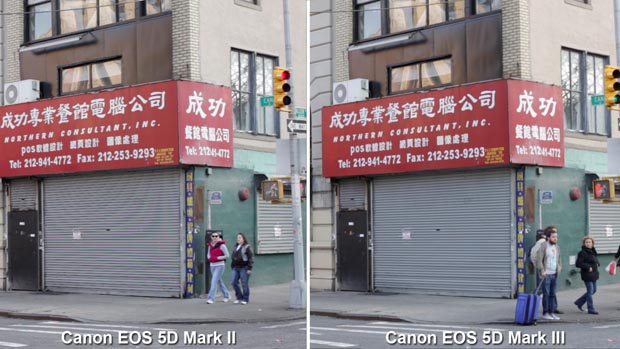 Back to selection
Back to selection
Good Things in Smaller Packages

For those of us excited by the advent of large-sensor motion picture cameras, this past year has been the Great Leap Forward.
Signs are everywhere. ARRI’s ALEXA swept TV series production in the U.S. Canon harnessed Hollywood pomp for the November launch of its C300. RED placed an eight-page glossy fold-out to tout EPIC in April’s Vogue (“The camera that changed cinema is now changing fashion”). Sony shipped no less than 100 F65s, the first Super 35 camera with an 8K sensor.
A year ago, in “Does Size Matter?” I surveyed the still-budding field of large-sensor cameras for Filmmaker and described the industry’s growing embrace of the 120-year-old Super 35 format. Not only were existing cine and SLR lenses given a new lease on life, I reported, but also overnight the market for new PL lenses had exploded. Spurring, in turn, new sensor designs with unprecedented sensitivity and low noise.
I also highlighted the latest large-sensor cameras, included the Sony NEX-VG10, Panasonic AG-AF100, Sony NEX-FS100, Sony PMW-F3, RED EPIC-M, ARRI ALEXA, Aaton Delta-Penelope and something I dubbed the Sony “8K Cineaste camera” — now called F65. I noted the drawbacks of HDSLRs, including moiré patterns due to image aliasing, poor connectivity, control and ergonomics.
For the skinny on these cameras — I won’t repeat in-depth descriptions here — I suggest revisiting this article online. For an in-depth appraisal of the Canon C300 and RED Scarlet-X, both introduced later in November, see my Filmmaker blog entry “New Super 35 Digital Motion Picture Cameras from Canon and RED — What They Are and Aren’t.”
For an update on the impact of large-sensor cameras, particularly Canon’s EOS 5D Mark II, on indie feature filmmaking, along with a discussion of Super 35 and “full frame” sensor sizes, see my February Filmmaker blog, “Festival Cinematography Notes: Of Sundance, Berlin, and the Canon 5D.”
So what’s the latest in large-sensor cameras?
As it happens, I’m writing this on the eve of the NAB Show, the annual convention of the National Association of Broadcasters, which begins mid-April in Las Vegas. The NAB Show is an enormous international equipment exhibition like the Consumer Electronics Show (also held at the same massive Vegas convention center). So influential is this show that camera manufacturers set their calendars and product cycles to it. In the months leading up to NAB, most withhold news of their significant products so that they can make the biggest possible splash with the international press attending NAB.
So the following descriptions of new and upcoming cameras are, to the best of my knowledge, accurate — but expect further developments during and after NAB.
And while contemplating this latest batch of large-sensor cameras, keep in mind these three emerging trends:
1) Shrinking size.
The RED EPIC-X, Sony FS100, Canon C300 and ARRI ALEXA-M each fit comfortably in a shoebox. In addition to Moore’s Law, forces driving this trend (besides James Cameron, in the case of the ALEXA-M) include physical requirements of 3D and Steadicam rigs, the convenience and peace-of-mind of flying with your camera as a carry-on and changing expectations of what a large-sensor camera can be — this last one set in motion by the extreme compactness of HDSLRs.
2) Better HD from DSLRs.
As detailed in last year’s large-sensor camera round-up, DSLRs are accidental video cameras. What was envisioned as a helpful added feature — enabling pro photographers to capture the occasional HD clip — has transformed the DSLR into the HD camera of choice for a generation of young filmmakers. Which, in turn, has influenced the look not only of music videos, but high-end commercials and feature films. Expect not only better codecs, audio controls and output choices, but effective solutions to the unsightly color moiré caused by use of an optical low pass filter appropriate to still photos but not HD. Exhibit A is Canon’s EOS 5D Mark III.
3) Arrival of Quad HD, aka 4K.
For two years in a row, Sony’s slogan at theNAB Show has been “Beyond HD.” Waiting in the wings is the industry’s new video format, Quad HD, so called because it multiplies Full HD 1920 x 1080 by a factor of two to get 3840 x 2160 (aka QFHD for Quad Full HD, or simply 3.8K). This means four times the pixels — at four times the signal size of HD. Stick another 128 pixels at both ends and you get 4096 x 2160, the cinema version, sometimes called 4K2K.
How imminent? For two years running Panasonic has showcased prototype 4K2K plasma displays at January’s Consumer Electronics Show — yes, aimed at consumers — while Sony put a 56-inch Quad HD LCD set on the market in 2009.
What to view? You may have heard the news about JVC’s GY-HMQ10, “the world’s first 4K handheld camcorder,” introduced in January at the Consumer Electronics Show. Not a large-sensor camcorder — its 8.3 megapixel CMOS is slightly smaller than a half inch — but a single-sensor device with a Bayer pattern to capture Quad HD, just like the big boys. Several details, however, place the GY-HMQ10 in a realm of its own: 1) it records a 3840 x 2160 image in four quadrants to four SD cards simultaneously using AVCHD (the 4K image is reassembled in FCP X for editing); 2) it provides four HDMI outputs; and 3) it lists for under $5,000.
How to play Quad HD? While many are still adjusting to the vicissitudes of H.264, work is already well underway on High Efficiency Video Coding, dubbed H.265. Perhaps a year away from adoption, it promises twice the efficiency of H.264, just as H.264 proved twice as efficient as MPEG-2. One goal of H.265 is compressed 4K at about 25 Mbps, a bit rate identical to DV a decade ago — which Blu-ray and cable systems can deliver today.
What’s all this got to do with large-sensor cameras?
4K is the next milestone on the future-products roadmap of most television manufacturers. Cameras will be first. (Think of JVC’s 4K handheld camcorder as an opening salvo.) Large-sensor cameras like the Canon C300 and Sony NEX-FS700 (described below), for instance, already contain 4K sensors, even though neither camera can capture or output 4K. But you can bet on the following: if a camera is designed with a latent capability, it is only a matter of time before that capability is expressed. (Same holds true, by the way, for 4K cameras with 8K sensors.)
Whether called Quad HD or 4K, this arrival of this high-resolution format will surely visit new challenges upon production and budgets. Lenses will have to ante up to 4K resolution. Recording that does not exploit compression will require four times more storage, compared to HD or 2K.
Will images look four times better? They’ll certainly look more spectacular than ever, even from “affordable” cameras, because we have never really seen end-to-end 4K on the big screen before. While the 4K bar was set some time ago by the ideal resolution of 35mm original camera negative, it’s generally accepted that, in practice, after multiple duping and mechanical projection of release prints, 35mm film images on the big screen were hardly ever better than 1K.
Today’s DCPs, whether projected as 2K or 4K, are sharp, clean and 100 percent steady. I think they’ve raised expectations of what contemporary cinema images should look like. (Seen a scratched, spiced, dirty film print lately? It can be a shock.) I happen to think such expectations are also being reinforced from other directions. Call it the “Retina Display” effect. I suspect that little kids who grow up clutching a new iPad or iPhone 4S will never know what a pixel is — and won’t want to know. Just as today there are fledgling digital filmmakers who disdain the texture of film grain.
But that’s for the future to sort out.
Below are preliminary notes and brief updates on the current crop of large-sensor cameras, including some that, as I write this, are about to be announced at the NAB Show. As with last year’s crop, these notes are introductory, not comprehensive. There will be an outpouring of information and opinion about these products on the Internet, for months to come.
We’ll overlook large-sensor developments in 3D, still a specialty market despite the commercial and artistic breakthroughs of the past year (Wim Wenders’ Pina, Herzog’s Cave of Forgotten Dreams, Scorsese’s Hugo — the last shot with ARRI ALEXAs).
As for meaningful small-sensor developments at NAB, like the rise in single-sensor camcorders (JVC’s 4K camcorder, Sony’s PMW-100 XDCAM) or Sony’s innovative HXR-NX30 camcorder with built-in pico projector and gyro-stabilized zoom — the entire lens floats like an unhinged eyeball — these I will visit in upcoming Filmmaker blog entries. Stay tuned.
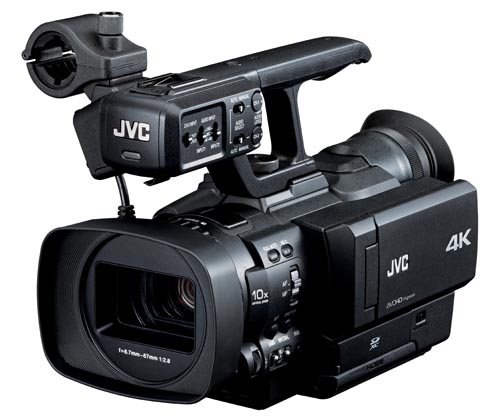
Canon EOS C300
$16,000 with PL or EF mount (two models), no lens
In my blog entry from November, “New Super 35Digital Motion Picture Cameras from Canon and RED – What They Are and Aren’t,” I detailed the C300’s attributes and discussed the unique sampling lattice of its Bayer sensor that creates each pixel from a cluster of four photosites: two green, one red and one blue. In other words, it’s a Quad HD sensor dedicated to HD-only output. Since every pixel is informed by a full complement of RGB samples, de-Bayering is unnecessary. (No color detail has to be invented.) Moreover, doubling up on the green pixel doubles green saturation, increases green dynamic range and bit depth in signal processing, and virtually eliminates green aliasing.
This is in theory, of course, but Canon recently loaned me a C300 and a set of 24mm, 50mm and 85mm EF primes for several weeks, and I can report that it’s true: the C300’s images appear, and feel, outstandingly clear and razor sharp. I promise to write more about the C300’s image achievements on the Filmmaker blog, because there’s much more to report about this camera.
In my hands, the C300 felt larger, heavier and more solid than I had surmised from photographs. My impression of the build quality is that Canon spared no expense in designing and fabricating their first Super 35 digital motion picture camera.
The C300 passed my “look ma, no manual” test with flying colors too. Key parameters are displayed film-style or video-style: your choice of dB gain or ISO (up to 30 dB and ISO 20,000), and shutter speed or angle. Controls are where expected, menus well-designed (using fine text and orange highlighting), and the handgrip proves to be a virtual control center, with a 2x magnification button, start/stop button, joystick for menu control and Canon-style control dial for iris adjustment (EF lenses). Ideal arrangement for hand-held work.
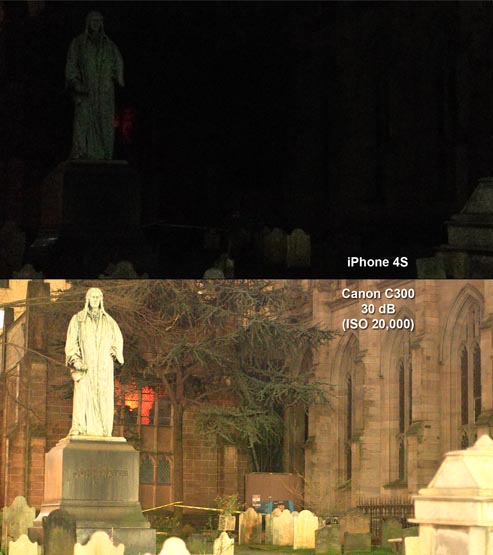
Canon EOS C500
No price yet. PL and EF mount models.
Ever stared out the window and daydreamed of a C300 with 10-bit 4K RAW workflow? You’re not alone. At NAB, Canon will show working models of the C500, a camera under development based on the C300 that will boost Canon to the stratosphere of digital cinema cameras. With a newly developed 8.85 megapixel Super 35 sensor, the C500 will output to an external recorder 4K RAW (4096 x 2160) up to 60 fps via 3G-SDI, and 4K “half RAW” (4096 x 1080) up to 120 fps via dual 3G-SDI links. With Canon Log gamma, of course.
Alternatively, the C500 will output Quad HD (3840 x 2160), 2K (2048 x 1080), and Full HD (1920 x 1080), this last one as what Canon calls “serial YCC,” meaning 10-bit 4:2:2 up to 120 fps. A Full HD “proxy” for editing can also be recorded to onboard CompactFlash cards.
ISO range is same as the C300: 320 to 20,000. Unlike the C300, the handgrip will be permanent. Otherwise they could be twins.
Canon won’t comment on projected availability, but it’s a safe bet that it will appear well before the next NAB.
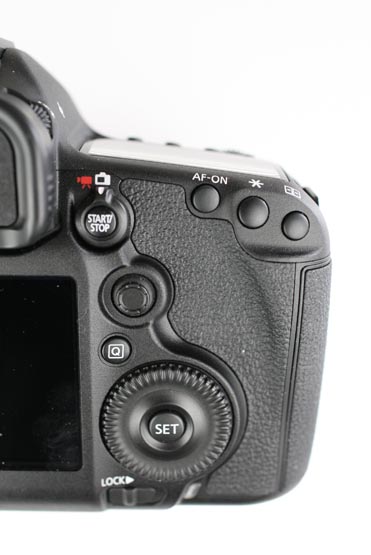
Canon EOS 5D Mark III
$3,500, body only
I also had the opportunity to test the new 5D Mark III with EF primes. At first it looks and feels like a 5D Mark II, but design tweaks soon grow apparent. It presents a larger 3.2-inch LCD compared to the 3.0-inch screen of the Mark II. There’s a new, dedicated Live View switch with start/stop for HD capture, all next to the viewfinder and within thumb’s reach. At last, there’s a headphone jack with audio level controls. Against the CompactFlash slot is a smaller slot that accepts SD cards.
Changes on the inside are more significant. A new 22.3 megapixel sensor replaces the 21.1 megapixel sensor of the Mark II, complemented by a turbocharged DIGIC 5+ processor (17 times faster than DIGIC 4). Canon says that lines are no longer skipped when recording HD, which should eliminate much of the false color moiré due to line aliasing that plagued the 5D Mark II. Gone is the 4GB file limit. Expanded a stop higher is the ISO range, to 12,800, with High Sensitivity modes up to 25,600. Included are all common HD and SD formats, along with an innovative choice of standard interframe or high-quality intraframe (all I-frame) H.264 compression.
Although the 5D Mark III costs more than the Mark II, these upgrades are essential and worth every penny. Still no clean HDMI output however.
Canon EOS-1D C
No price yet
The mystery camera shown under glass at November’s launch of the C300 at Paramount Studios can now be revealed: a cinema version of the new full-frame EOS-1D X that will be called EOS-1D C.
Featuring the same 18.1 megapixel sensor as the 1D X, the 1D C introduces something entirely new: 4K directly to CompactFlash. (Like the 1D X, the 1D C has twin CF slots.) How is this possible? The answer is 8-bit Motion JPEG compression limited to a single frame rate: 24 fps. (Bit rate not available at time of writing.)
A proviso regarding native 4K capture is that the requisite 4096 x 2160 pixels are cropped from the larger 24 mm x 36 mm full-frame sensor. The resulting 4K image is the size of APS-H, about halfway between full frame and Super 35 (also APS-C). An ironic consequence is that Canon’s own EF Cinema Zooms, tailored to Super 35, won’t cover 4K capture on this camera.
Full HD can be created one of two ways: 1) capturing the full sensor and supersampling to produce an HD image, or 2) taking a Super 35 crop of the full sensor, which permits use of Super 35 lenses like the EF Cinema Zooms. Both possibilities are tantalizing.
The 1D C’s ISO range is the same as 1D X: a whopping 100 to 204,800. And finally an EOS HDSLR offers clean, uncompressed HD via HDMI. Even while monitoring on the camera’s LCD. And one more thing: a headphone jack.
Nikon D800
$3,000, body only
As yet, Nikon hasn’t been able to supply a loaner for me to test, but they promise to soon, and when they do, I’ll contribute a Filmmaker blog entry about it. Meanwhile, based on description alone, Nikon appears in it to win it.
Impressive are a 36.3 megapixel full-frame sensor (remember, HD requires only 2 megapixels, the multiple of 1920 x 1080), a 3.2-inch LCD, an ISO up to 6,400 with High Sensitivity modes up to 25,600, dual CF and CS slots, and an audio headphone jack.
But the killer feature is its recordable, 4:2:2 HDMI output, coupled with the ability to monitor both the D800’s LCD and an external monitor simultaneously. Like the Canon EOS 5D Mark III, the D800 also offers high-quality intraframe H.264 compression, although it records only Full HD (1920 x 1080) at 24, 25, and 30 fps. No 720p or SD. A unique feature of the D800 is the choice of capturing HD using its full-frame mode, called FX, for shallowest depth of field — or using a smaller portion of the sensor equivalent to Super 35, called DX, which provides horizontal angles of view and depth of field familiar to veteran cinematographers.

Sony NEX-FS100
$5,000, body only
A year old, the FS100 feels almost venerable. I’ve shot extensively with it, here and in Europe. Although it is AVCHD only, Sony’s codec is superb and I’ve never experienced so much as a single artifact. My best compliment is that this little camera is so good, the image it produces seems limited only by the quality of the lens placed before it. Of course this is not a top-shelf camera and can’t match the specs or tonal scale prowess of the F3 (with which it shares a sensor) or F65, but when scene contrast is under control, it sure seems to! One of my favorite features remains the FMU, a 128 GB solid state drive the size of a MiniDV cassette that snaps into the side of the FS100 and records up to 11 hours at the highest AVCHD quality. I never worry about bringing media any more, particularly on documentary shoots.
At NAB, Sony will launch a Web micro-site that offers, free to FS100 owners, a software download in both Mac and PC flavors for a do-it-yourself firmware upgrade. Upgraded features include: 60Hz/50Hz selection (yes!), up to 99 camera profiles — all menu, button, picture profile settings — saved to an SD card (no provision to name them however), two new expanded focus modes, 4x and 8x, in an expanded focus window that can be moved around the scene (its position remembered), added frame line markers for 1.85 and 2.35, and display choices of ISO/gain, feet/meters and shutter speed/angle.
Sony NEX-FS700
$8,000 (estimated street), body only
An oft-heard complaint about the FS100 was lack of built-in NDs. This didn’t bother me much, as film cameras didn’t have built-in NDs either. But Sony listened and its new FS700 is the result. It resembles an FS100 but with a filter turret of 2-, 4- and 6-stop NDs grafted to the far side of the lens mount. And this is only the beginning of what sets the FS700 apart from the FS100…
Outwardly the FS700 is longer, possibly long enough for shoulder mounting. The hand grip, which has gained expanded focus and push auto-iris buttons, is attached by an ARRI rosette! This opens the FS700 to a universe of ARRI handgrips and support attachments. Instead of the FS100’s shaky handle attached by a photo shoe, a new, dedicated handle (removable) is firmly bolted by two heavy screws.
But the real fireworks are inside. Although offering the same native ISO 500 as the FS100 with identical AVCHD compression, the FS700 introduces a new 11.6 megapixel 4K Super 35 sensor. Like the 4K sensor in Canon’s C300, this promises spectacular, oversampled HD.
Intriguingly, Sony calls the F700 “4K ready.” I’m not sure what this means, but given my earlier remark about latent capabilities eventually expressed, don’t be surprised in the future by 4K RAW output at a bit rate higher than 8, perhaps to a Sony SR-R1 solid state recorder, like the F3 does now.
Meanwhile, besides AVCHD, the FS700 provides 3G-SDI output of 4:2:2, 8-bit 24/30/60p and 25/50p formats.
It also introduces Super Slow Motion, a trick heretofore limited to specialized high-speed cameras costing many times more. At Full HD (1920 x 1080), it can shoot 16 seconds at 120 fps or 8 seconds at 240 fps. It can also shoot 480 fps at 1920 x 432 (using a line-skipping technique), which is interpolated to 1920 x 1080 for recording. Similarly, it can shoot 960 fps (!) at 1920 x 216.
This is going to be a wildly popular capability.
The FS700 already contains all of the firmware upgrades mentioned above for FS100. Further, using Sony’s LA-EA2 adapter for Sony Alpha lenses, the F700 gains a remarkable auto-focus capability that includes face detection. Someone can walk toward you and the FS700 will automatically track their position and pull its own focus, with no hunting and pecking. I tried it, and it works.
Sony PMW-F3
$14,000, body only, S-Log included
Sony’s F3 is also a year old, with over 3,000 inthe field, and responsible for a handful of indie films on the fest circuit. (See my Filmmaker blog entry about Sundance and Berlin.) Perhaps the biggest news regarding the F3 on the eve of NAB is that Sony has just announced that the S-Log firmware upgrade, formerly a $3,000 item, is now free, included in the price of new F3s.
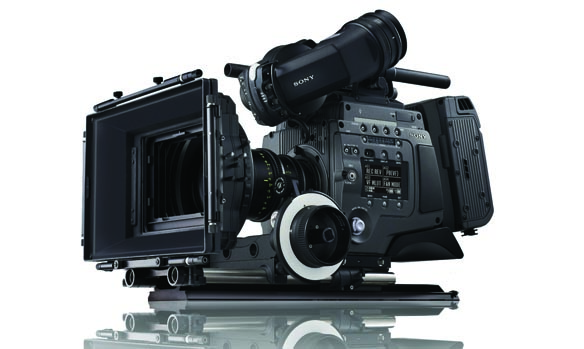
Sony F65
$65,000
As I write this, M. Night Shyamalan is filming Sony Pictures’ After Earth starring Will Smith in Pennsylvania with this camera that was barely past the breadboard stage a year ago. With 400 orders worldwide, Sony seems to have another hit on its hands. What sets the F65 apart, aside from its price — half of what the heavier, larger F35 cost several years ago — is its 20.4 megapixel Super 35 8K sensor.
8K takes supersampling for HD and 2K output to a whole new level, which is why the F65 will likely carve out a chunk of high-end TV production. But an 8K sensor also enables true 4K, contributing a full RGB sample to each pixel. No time-consuming de-Bayering interpolations. No other 4K camera can claim this.
To eliminate the CMOS rolling shutter, the F65 offers an optional rotary shutter. Interestingly, I was told four NDs are sandwiched in the shutter and rotate too. (Can’t quite figure out how this would work.) In the little-things-that-count department, NDs are marked properly as 0.3, 0.6, 0.9 and 1.2.
With an extended color gamut (beyond color negative), 120 fps, 16-bit linear RAW recording to SRMemory cards and an ergonomic profile resembling a film camera more than anything Sony has designed before, a challenge to the industry has been thrown down.
RED EPIC-X and SCARLET-X
$38,000 and $13,200, with PL mount
I detailed SCARLET’s long and winding path in my November camera blog entry, so suffice it to say that RED, the industry’s 4K pioneer, is doing very well, thank you, having expanded and settled into the old Ren-Mar Studios (where The Artist was filmed), rechristening it RED STUDIOS HOLLYWOOD (their caps). They deserve Brownie points for bringing back to the U.S. all their camera manufacturing. A Canon EF mount version of SCARLET-X, a stripped version of EPIC, lists for $11,700.
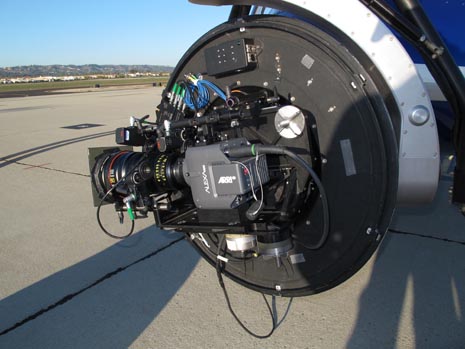
ARRI ALEXA-M and STUDIO
Basic model under $90,000
It’s been a triumphant year for ALEXA, as mentioned at the top. ALEXA-M, a camera head severed from its body (the joke amongst ARRI employees was that M stood for Marie Antoinette) is now making inroads into 3D and specialty realms requiring compact cameras. As you can see in the photo, the head is still connected to the body via a thick cable, so ALEXA-M doesn’t qualify as a discrete compact camera. On a helicopter this doesn’t matter, obviously.
Perhaps more significant is the arrival of the long-awaited ALEXA STUDIO model. Instead of an electronic viewfinder, ALEXA STUDIO incorporates an adjustable spinning mirror shutter and optical viewfinder, long a request of experienced d.p.s and operators. It’s just like shooting film, minus the soft whir of pulldown claws and sprocket drives.
Further, the ALEXA STUDIO’s Super 35 sensor is 4:3 in shape, taller than the common 16:9 shape. Because of this, conventional anamorphic lenses can be used to create a uniquely cinematic widescreen depth-of-field. Aside from ARRI’s earlier D-21 camera, ALEXA STUDIO is the only current Super 35 camera that can accommodate anamorphic images.
P+S Technik PS Cam X35
$90,000+
I first encountered this shoulder-style, PL-mount camera last summer at Cine Gear in Los Angeles. Built like a tank by P+S Technik in Munich, it suggested an ALEXA with black wrinkle paint and extremely high frame rates,150-450 fps. Otherwise its specs are similar to ALEXA’s. Designed as a versatile, all-purpose camera, it will probably see most use as a companion camera in TV episodics requiring slow motion.
Panasonic ?
Missing in action is Panasonic, which unveiled its Micro Four Thirds (smaller than Super 35) AG-AF100 two years ago at NAB. I contacted them for this article but was told no announcements would be forthcoming before NAB. Let’s hope they have a big surprise for us up their corporate sleeve.
The take-away from this year’s riot of new large-sensor cameras?
It’s a win, win, win for filmmakers, manufacturers and audiences alike. Costs are dropping, sales are rising, capabilities are growing and cinematography is getting to be really fun again.
